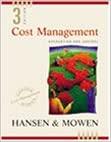Goldstein Company produces two types of vases (A and B). Both pass through two pro ducing departments:
Question:
Goldstein Company produces two types of vases (A and B). Both pass through two pro¬
ducing departments: Molding and Painting. It also has a Maintenance Department that ser¬
vices and repairs the equipment used in each producing department. Budgeted data for the three departments are given below.

In the Molding Department, Vase A requires 1 hour of direct labor and Vase B, 2 hours. In the Painting Department, Vase A requires 0.5 hours of direct labor and Vase B, 1 hour. Expected production: Vase A, 4,000 units; Vase B, 4,000 units.
Immediately after preparing the budgeted data, a consultant suggests that two manufac¬
turing cells be created: one for the manufacture of Vase A cind the other for the manufacture of Vase B. Cell workers would be trained to perform maintenance; hence, the Maintenance Department is decentralized. The total direct overhead costs estimated for each cell are $200,000 for Cell A and $184,000 for Cell B.
Required:
1. Allocate the service costs to each department, and compute the overhead cost per unit for each vase. (Overhead rates use direct labor hours.)
2. Compute the overhead cost per unit if manufacturing cells are created. Which unit over¬
head cost do you think is the more accurate—the one computed with a departmental structure or the one computed using a cell structure? Explain.
3. Note that the total overhead costs under each system are assumed to be the same. Would you expect the overhead costs to remain the same if the JIT manufacturing system is implemented? Explain.
Step by Step Answer:

Cost Management Accounting And Control
ISBN: 9780324002324
3rd Edition
Authors: Don R. Hansen, Maryanne M. Mowen





